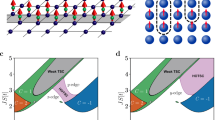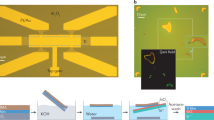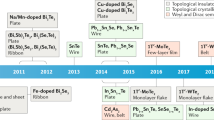Abstract
Topological superconductivity can emerge from the combination of conventional superconductivity in a metal and strong spin–orbit coupling in a semiconductor when they are made into a hybrid device. The most exciting manifestation of topological superconductivity is the Majorana zero modes that are predicted to exist at the ends of the proximatized nanowires. In this Perspective, we review the evidence for the existence of Majorana zero modes that has accumulated in numerous experiments and the remaining uncertainties, and discuss what additional evidence is desirable. One very important factor for future development is the quality of the interface between the superconductor and semiconductor; we sketch out where further progress in the materials science of these interfaces can take us. We then discuss the path towards applying these modes in topologically protected quantum computing and observing more exotic kinds of superconductivity based on the same materials platform, and how to make connections to high-energy physics.
This is a preview of subscription content, access via your institution
Access options
Access Nature and 54 other Nature Portfolio journals
Get Nature+, our best-value online-access subscription
$29.99 / 30 days
cancel any time
Subscribe to this journal
Receive 12 print issues and online access
$209.00 per year
only $17.42 per issue
Buy this article
- Purchase on Springer Link
- Instant access to full article PDF
Prices may be subject to local taxes which are calculated during checkout




Similar content being viewed by others
References
Read, N. & Green, D. Paired states of fermions in two dimensions with breaking of parity and time-reversal symmetries and the fractional quantum hall effect. Phys. Rev. B 61, 10267–10297 (2000).
Ivanov, D. A. Non-abelian statistics of half-quantum vortices in p-wave superconductors. Phys. Rev. Lett. 86, 268–271 (2001).
Kitaev, A. Y. Fault-tolerant quantum computation by anyons. Ann. Phys. 303, 2–30 (2003).
Volovik, G. E. Fermion zero modes on vortices in chiral superconductors. J. Exp. Theor. Phys. Lett. 70, 609–614 (1999).
Fu, L. & Kane, C. L. Superconducting proximity effect and Majorana fermions at the surface of a topological insulator. Phys. Rev. Lett. 100, 096407 (2008).
Lutchyn, R. M., Sau, J. D. & Das Sarma, S. Majorana fermions and a topological phase transition in semiconductor-superconductor heterostructures. Phys. Rev. Lett. 105, 077001 (2010).
Oreg, Y., Refael, G. & von Oppen, F. Helical liquids and Majorana bound states in quantum wires. Phys. Rev. Lett. 105, 177002 (2010).
Kitaev, A. Y. Unpaired Majorana fermions in quantum wires. Phys. -Uspekhi 44, 131–136 (2001).
Sengupta, K., Žutić, I., Kwon, H.-J., Yakovenko, V. M. & Das Sarma, S. Midgap edge states and pairing symmetry of quasi-one-dimensional organic superconductors. Phys. Rev. B 63, 144531 (2001).
Liu, C.-X., Cole, W. S. & Sau, J. D. Proposal for measuring the parity anomaly in a topological superconductor ring. Phys. Rev. Lett. 122, 117001 (2019).
Krogstrup, P. et al. Epitaxy of semiconductor–superconductor nanowires. Nat. Mater. 14, 400–406 (2015).
Shabani, J. et al. Two-dimensional epitaxial superconductor-semiconductor heterostructures: A platform for topological superconducting networks. Phys. Rev. B 93, 155402 (2016).
Gazibegovic, S. et al. Epitaxy of advanced nanowire quantum devices. Nature 548, 434–438 (2017).
Sugaya, T., Okada, Y. & Kawabe, M. Selective growth of GaAs by molecular beam epitaxy. Jpn. J. Appl. Phys. 31, L713 (1992).
Nishinaga, T. & Bacchin, G. Selective area MBE of GaAs, AlAs and their alloys by periodic supply epitaxy. Thin Solid Films 367, 6–12 (2000).
Mourik, V. et al. Signatures of Majorana fermions in hybrid superconductor-semiconductor nanowire devices. Science 336, 1003–1007 (2012).
Das, A. et al. Zero-bias peaks and splitting in an Al-InAs nanowire topological superconductor as a signature of Majorana fermions. Nat. Phys. 8, 887–895 (2012).
Deng, M. et al. Anomalous zero-bias conductance peak in a Nb–InSb nanowire–Nb hybrid device. Nano. Lett. 12, 6414–6419 (2012).
Finck, A. D. K., Van Harlingen, D. J., Mohseni, P. K., Jung, K. & Li, X. Anomalous modulation of a zero-bias peak in a hybrid nanowire-superconductor device. Phys. Rev. Lett. 110, 126406 (2013).
Churchill, H. O. H. et al. Superconductor-nanowire devices from tunneling to the multichannel regime: Zero-bias oscillations and magnetoconductance crossover. Phys. Rev. B 87, 241401 (2013).
Lee, E. J. H. et al. Spin-resolved andreev levels and parity crossings in hybrid superconductor-semiconductor nanostructures. Nat. Nanotechnol. 9, 79–84 (2014).
Liu, C.-X., Sau, J. D., Stanescu, T. D. & Das Sarma, S. Andreev bound states versus Majorana bound states in quantum dot-nanowire-superconductor hybrid structures: trivial versus topological zero-bias conductance peaks. Phys. Rev. B 96, 075161 (2017).
Vuik, A., Nijholt, B., Akhmerov, A. R. & Wimmer, M. Reproducing topological properties with quasi-Majorana states. SciPost Phys. 7, 061 (2019).
Kells, Meidan, G. D. & Brouwer, P. W. Near-zero-energy end states in topologically trivial spin-orbit coupled superconducting nanowires with a smooth confinement. Phys. Rev. B 86, 100503 (2012).
Pan, H., Cole, W. S., Sau, J. D. & Das Sarma, S. Generic quantized zero-bias conductance peaks in superconductor-semiconductor hybrid structures. Phys. Rev. B 101, 024506 (2020).
Brouwer, P. W. & Beenakker, C. W. J. Insensitivity to time-reversal symmetry breaking of universal conductance fluctuations with Andreev reflection. Phys. Rev. B 52, 16772 (1995).
Altland, A. & Zirnbauer, M. R. Random matrix theory of a chaotic andreev quantum dot. Phys. Rev. Lett. 76, 3420–3423 (1996).
Albrecht, S. M. et al. Exponential protection of zero modes in Majorana islands. Nature 531, 206–209 (2016).
Deng, M. T. et al. Majorana bound state in a coupled quantum-dot hybrid-nanowire system. Science 354, 1557–1562 (2016).
Chen, J. et al. Experimental phase diagram of zero-bias conductance peaks in superconductor/semiconductor nanowire devices. Sci. Adv. 3, e1701476 (2017).
Nichele, F. et al. Scaling of Majorana zero-bias conductance peaks. Phys. Rev. Lett. 119, 136803 (2017).
Kjaergaard, M. et al. Quantized conductance doubling and hard gap in a two-dimensional semiconductor–superconductor heterostructure. Nat. Commun. 7, 12841 (2016).
Grivnin, A., Bor, E., Heiblum, M., Oreg, Y. & Shtrikman, H. Concomitant opening of a bulk-gap with an emerging possible majorana zero mode. Nat. Commun. 10, 1940 (2019).
Chen, J. et al. Ubiquitous non-Majorana zero-bias conductance peaks in nanowire devices. Phys. Rev. Lett. 123, 107703 (2019).
Rokhinson, L. P., Liu, X. & Furdyna, J. K. The fractional a.c. Josephson effect in a semiconductor–superconductor nanowire as a signature of Majorana particles. Nat. Phys. 8, 795–799 (2012).
Houzet, M., Meyer, J. S., Badiane, D. M. & Glazman, L. I. Dynamics of majorana states in a topological Josephson junction. Phys. Rev. Lett. 111, 046401 (2013).
Billangeon, P.-M., Pierre, F., Bouchiat, H. & Deblock, R. Ac Josephson effect and resonant Cooper pair tunneling emission of a single Cooper pair transistor. Phys. Rev. Lett. 98, 216802 (2007).
Anselmetti, G. L. R. et al. End-to-end correlated subgap states in hybrid nanowires. Preprint at https://arxiv.org/abs/1908.05549 (2019).
Yu, P. et al. Non-majorana states yield nearly quantized conductance in superconductor-semiconductor nanowire devices. Preprint at https://arxiv.org/abs/2004.08583 (2020).
Akhmerov, A. R., Dahlhaus, J. P., Hassler, F., Wimmer, M. & Beenakker, C. W. J. Quantized conductance at the Majorana phase transition in a disordered superconducting wire. Phys. Rev. Lett. 106, 057001 (2011).
Rosdahl, T. Ö., Vuik, A., Kjaergaard, M. & Akhmerov, A. R. Andreev rectifier: a nonlocal conductance signature of topological phase transitions. Phys. Rev. B 97, 045421 (2018).
Fu., L. Electron teleportation via Majorana bound states in a mesoscopic superconductor. Phys. Rev. Lett. 104, 056402 (2010).
Michaeli, K., Landau, L. A., Sela, E. & Fu, L. Electron teleportation and statistical transmutation in multiterminal Majorana islands. Phys. Rev. B 96, 205403 (2017).
Motrunich, O., Damle, K. & Huse, D. A. Griffiths effects and quantum critical points in dirty superconductors without spin-rotation invariance: one-dimensional examples. Phys. Rev. B 63, 224204 (2001).
Ren, H. et al. Topological superconductivity in a phase-controlled Josephson junction. Nature 569, 93–98 (2019).
Fornieri, A. et al. Evidence of topological superconductivity in planar Josephson junctions. Nature 569, 89–92 (2019).
Alicea, J., Oreg, Y., Refael, G., von Oppen, F. & Fisher, M. P. A. Non-abelian statistics and topological quantum information processing in 1D wire networks. Nat. Phys. 7, 412–417 (2011).
Van Heck, B., Akhmerov, A. R., Hassler, F., Burrello, M. & Beenakker, C. W. J. Coulomb-assisted braiding of Majorana fermions in a Josephson junction array. New. J. Phys. 14, 035019 (2012).
Karzig, T. et al. Scalable designs for quasiparticle-poisoning-protected topological quantum computation with Majorana zero modes. Phys. Rev. B 95, 235305 (2017).
Stenger, J. P. T., Hatridge, M., Frolov, S. M. & Pekker, D. Braiding quantum circuit based on the 4π Josephson effect. Phys. Rev. D. 99, 035307 (2019).
Krizek, F. et al. Field effect enhancement in buffered quantum nanowire networks. Phys. Rev. Mater. 2, 093401 (2018).
Aseev, P. et al. Selectivity map for molecular beam epitaxy of advanced III–V quantum nanowire networks. Nano Lett. 19, 218–227 (2018).
Lee, J. S. et al. Selective-area chemical beam epitaxy of in-plane InAs one-dimensional channels grown on InP (001), InP (111) B, and InP (011) surfaces. Phys. Rev. Mater. 3, 084606 (2019).
Friedl, M. et al. Template-assisted scalable nanowire networks. Nano Lett. 18, 2666–2671 (2018).
Rainis, D. & Loss, D. Majorana qubit decoherence by quasiparticle poisoning. Phys. Rev. B 85, 174533 (2012).
Lafarge, P., Joyez, P., Esteve, D., Urbina, C. & Devoret, M. H. Measurement of the even-odd free-energy difference of an isolated superconductor. Phys. Rev. Lett. 70, 994–997 (1993).
Pendharkar, M. et al. Parity-preserving and magnetic field resilient superconductivity in indium antimonide nanowires with tin shells. Preprint at https://arxiv.org/abs/1912.06071 (2019).
Bjergfelt, M. et al. Superconducting vanadium/indium-arsenide hybrid nanowires. Nanotechnology 30, 294005 (2019).
Carrad, D. J. et al. Shadow lithography for in-situ growth of generic semiconductor/superconductor devices. Preprint at https://arxiv.org/abs/1911.00460 (2019).
Barkeshli, M. & Sau, J. D. Physical architecture for a universal topological quantum computer based on a network of Majorana nanowires. Preprint at https://arxiv.org/abs/1509.07135 (2015).
Ebisu, H., Sagi, E. & Oreg, Y. Supersymmetry in the insulating phase of a chain of majorana cooper pair boxes. Phys. Rev. Lett. 123, 026401 (2019).
Chew, A., Essin, A. & Alicea, J. Approximating the Sachdev-Ye-Kitaev model with Majorana wires. Phys. Rev. B 96, 121119 (2017).
Clarke, D. J., Alicea, J. & Shtengel, K. Exotic non-abelian anyons from conventional fractional quantum Hall states. Nat. Commun. 4, 1348 (2013).
Lindner, N. H., Berg, E., Refael, G. & Stern, A. Fractionalizing majorana fermions: Non-abelian statistics on the edges of abelian quantum hall states. Phys. Rev. X 2, 041002 (2012).
Cheng, M. Superconducting proximity effect on the edge of fractional topological insulators. Phys. Rev. B 86, 195126 (2012).
Amet, F. et al. Supercurrent in the quantum Hall regime. Science 352, 966–969 (2016).
Moore, G. & Read, N. Nonabelions in the fractional quantum Hall effect. Nucl. Phys. B 360, 362–396 (1991).
Kitaev, A. Anyons in an exactly solved model and beyond. Ann. Phys. 321, 2–111 (2006).
Yao, H. & Kivelson, S. A. Exact chiral spin liquid with non-abelian anyons. Phys. Rev. Lett. 99, 247203 (2007).
Wess, J. & Bagger, J. Supersymmetry and supergravity (Princeton Univ. Press, 1992).
Friedan, D., Qiu, Z. & Shenker, S. H. Conformal invariance, unitarity and two-dimensional critical exponents. Phys. Rev. Lett. 52, 1575–1578 (1984).
Sachdev, S. & Ye, J. Gapless spin-fluid ground state in a random quantum Heisenberg magnet. Phys. Rev. Lett. 70, 3339–3342 (1993).
Kitaev, A. A Simple Model Of Quantum Holography (Part 1) http://online.kitp.ucsb.edu/online/entangled15/kitaev/ (UC Santa Barbara, 2015).
Kitaev, A. A Simple Model Of Quantum Holography (Part 2) http://online.kitp.ucsb.edu/online/entangled15/kitaev2/ (UC Santa Barbara, 2015).
Maldacena, J., Shenker, S. H. & Stanford, D. A bound on chaos. J. High. Energy Phys. 2016, 106 (2016).
Acknowledgements
We thank S. Das Sarma for comments. S.M.F. is supported by NSF DMR-1906325, NSF PIRE-1743717, ONR and ARO. M.J.M is supported by Microsoft Quantum. J.S. is supported by the NSF-DMR1555135 and helpful discussions at the KITP under Grant no. NSF PHY-1748958.
Author information
Authors and Affiliations
Corresponding author
Ethics declarations
Competing interests
The authors declare no competing interests.
Additional information
Publisher’s note Springer Nature remains neutral with regard to jurisdictional claims in published maps and institutional affiliations.
Rights and permissions
About this article
Cite this article
Frolov, S.M., Manfra, M.J. & Sau, J.D. Topological superconductivity in hybrid devices. Nat. Phys. 16, 718–724 (2020). https://doi.org/10.1038/s41567-020-0925-6
Received:
Accepted:
Published:
Issue Date:
DOI: https://doi.org/10.1038/s41567-020-0925-6
This article is cited by
-
Heterostructures coupling ultrathin metal carbides and chalcogenides
Nature Materials (2024)
-
Hosohedral nodal-line superconductivity in hexagonal ABC Dirac semimetals
Communications Physics (2024)
-
Investigation of magnetotransport properties of topological surface states in SnBi4Te7 single crystal
Journal of Materials Science: Materials in Electronics (2024)
-
Dirac-fermion-assisted interfacial superconductivity in epitaxial topological-insulator/iron-chalcogenide heterostructures
Nature Communications (2023)
-
Epitaxial substitution of metal iodides for low-temperature growth of two-dimensional metal chalcogenides
Nature Nanotechnology (2023)



